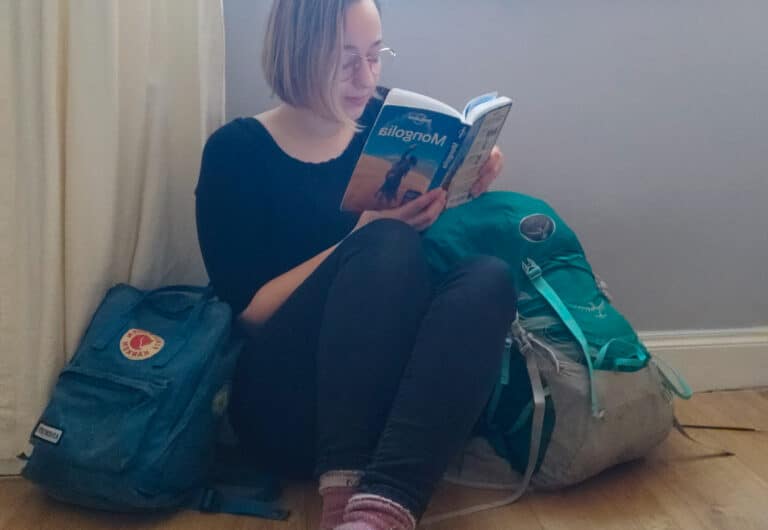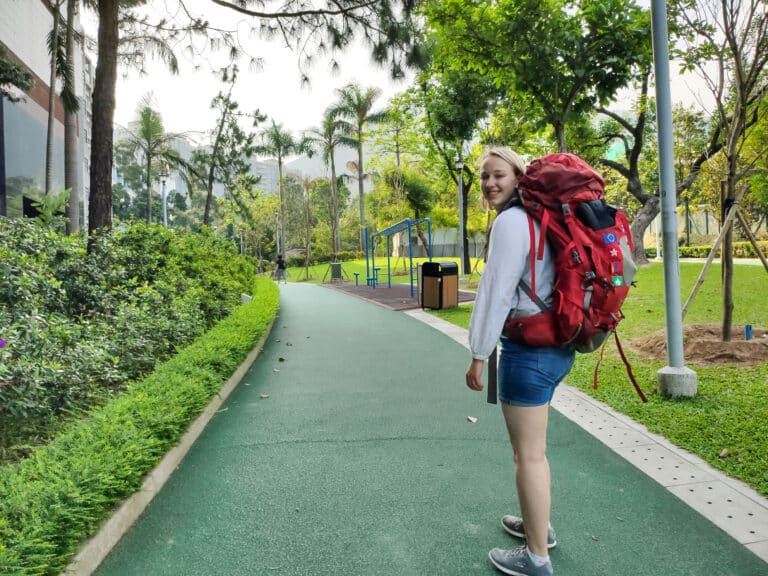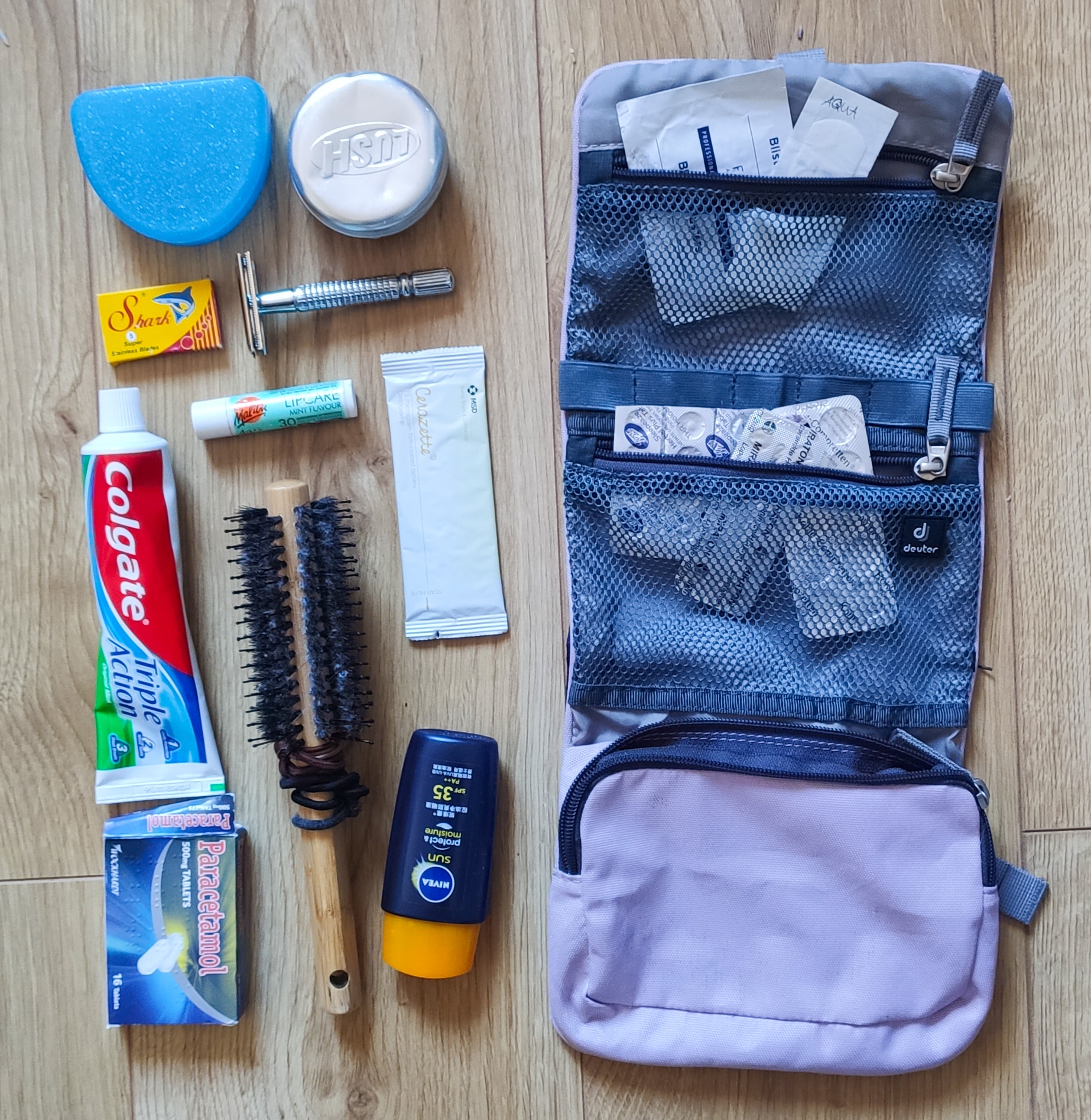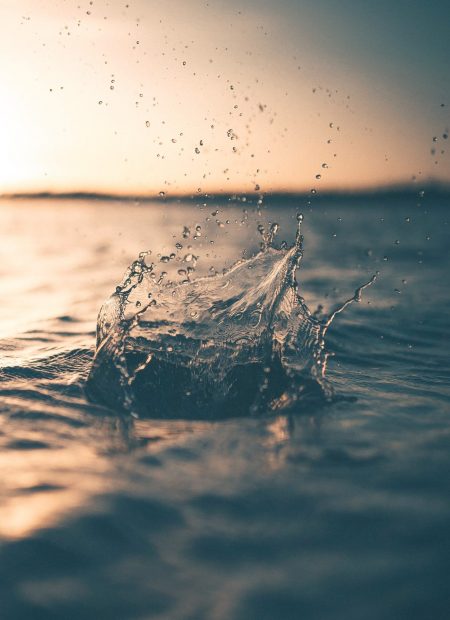
The eco-friendly travel packing list for backpackers [2023]
Packing light and packing less has transformed our travel experience and it can transform yours too. Less to carry = less stress. Packing less will also lower your carbon footprint, and making some eco-friendly swaps will ensure that you’re minimising your impact on the planet as much as possible. This complete eco-friendly travel packing list will ensure you don’t forget a single thing! It’ll also show you how to pack everything you need in a 30 – 40L backpack (I promise I’m not insane!).
Jump to:
The Eco-Friendly Travel Packing List
This eco-friendly travel packing checklist includes everything you need to pack, no matter how long your trip is. Don’t forget your passport and important documents too! For more advice on exactly what to pack, scroll down to see exactly what we pack on our travels.
Adjust this list accordingly for hot and cold weather and for specific activities that you’re planning on your trip. Use your common sense, if it’s cold you’ll want to bring a hat, gloves, scarf, thicker socks, possibly bigger boots if you plan to stay somewhere snowy. If you’re heading to a warmer country perhaps you could add in some sunglasses, a sun hat, some more dresses or swap a pair of trousers for an extra pair of shorts.
Luggage and Travel Bags
- Main backpack (30-40L)
- Day bag (10-15L)
- Packing cubes
- Money belt
- Drybag
Travel Toiletries & Medical Kit
- Quick-dry travel towel
- Toothbrush
- Toothpaste
- Shampoo bar
- Sunscreen
- Lip balm
- Mooncup
- Paracetamol/Ibuprofen
- Motion sickness tablets
- Hand sanitiser
- Prescription medication
- Items specific to country of travel, e.g. Malaria tablets, mosquito spray
Travel Documents
- Passport/visa(s)
- Transport tickets
- Personal ID, including a student ID card if you have one!
- Money
- Debit/credit cards
- Travel insurance information
- Emergency contacts and important addresses
- Notebook and pencil
Clothing
- Raincoat x1
- Jumper x1
- Puff jacket x1
- Tops x6 (mix of vest tops, T-shirts and shirts)
- Trousers x1
- Leggings x1
- Shorts x1
- Dress x1
- Underwear x8
- Socks x5
- Swimwear x1
- Sleepwear x1
- Trainers x1
- Sandals x1
Travel Tech
- Phone
- Camera
- Chargers
- Spare memory cards
- E-Reader
- Headphones
- Travel adaptor
- Powerbank
Travel Essentials
- Water-to-Go bottle
- Beeswax wraps
- Swiss army knife
- Reusable canvas bag
- Head torch
Want to download a free eco-friendly travel packing list? Just hit the button below and save it to your desktop or print straight away!

How to Pack Light
“Pack light move fast!”. That was my family’s motto growing up, and it’s stuck with me. I am a huge advocate for packing less. Packing light gives you more energy to explore. You won’t always be worried about where to drop your bags, having to head straight to your hostel, or running around trying to find a left-luggage as soon as you arrive in a new place. Instead, you’ll have the freedom to dictate your own adventures, not be dictated by the weight of your backpack.
You always need less than you think you do. That’s true for travel, and it’s probably true in life as well.
Here are our top tips for packing light
1.
Choose the right size backpack for your trip. No matter what size backpack you choose, you’ll fill it. Take into account the climate, what activities you’re planning, and if you want to leave room for souvenirs. I usually take a 16L backpack for short trips (1-4 days) and a 30L for anything longer unless I’m planning activities that need a lot of equipment.
2.
Work out how much you can comfortably carry. The maximum I can comfortably carry all day is 7 – 9 kg. If you can’t carry it or struggle to lift your bag, it’s too heavy. Don’t expect anyone else to carry your backpack or your things for you either.
3.
Write a checklist. Work out everything you’ll need for your trip and cross things off. Stick to your list so that you don’t fall into the trap of ‘ooohh I need to bring this!’ (happens to the best of us, me included). Get a free travel packing checklist here.
4.
Think about what kind of traveller you are. Know your travel style. Don’t pack for every situation, pack for the situations you’re likely to end up in. If you’re a hiker, bring your boots. If you like going to parties or fancy restaurants remember to pack nicer clothes. Cross off any gear from your list that doesn’t fit with the kind of traveller you are. Unless it’s a swimsuit. Always bring a swimsuit.
5.
Reduce weight but optimise function. If you’re buying new items go for well-designed ones. Opt for items that have multiple uses because this reduces weight and complexity. And when you’re packing clothes, layer layer layer! If your clothes layer, you’ll be prepared for every climate.
6.
Swap heavier items for lighter ones. Bring an e-reader instead of books. Swap a beach towel for a travel towel. Pack travel-sized toiletries instead of full bottles. And for goodness sake, leave the hairdryer! Most hotels have one, and if you’re heading into the wild, I promise you no one will care.
7.
Just buy it there! Remember, most of the time (unless you’re heading into the deep wilderness) you can buy the things you need on the way. Toiletries, an extra jumper, spare underwear, new socks. Most countries will stock the necessary items.
Travel Recommendations
This is a sustainable blog advocating for eco-friendly travel so I’ll be sharing some of my favourite products that are a win for people and the planet! You may notice that I point out particularly eco-friendly, ethical and sustainable brands throughout. Let’s break down what these phrases actually mean:
Ethical: used to point out the companies that have robust animal and garment worker welfare programs.
Eco-friendly: products that are made from earth-friendly materials – think less polyester and more natural fibres, such as cork and bamboo. They are usually more easily biodegradable or recyclable.
Sustainable: companies that are minimising their impact on the planet, for example, through production systems that involve recycled fabrics or use of renewable energy.
Best Travel Backpacks
Let’s start off this eco-friendly travel packing list with the best travel backpack. The size you’ll need will vary. I personally carry a 30L backpack, which is on the smaller side but is enough space for me to pack everything I need. I’d recommend a 40L backpack if you know you’re an over-packer, or want to leave space for bringing home lots of souvenirs. Anything over 40L is going to be heavy, uncomfortable and possibly keep you from having the best experience on your adventures. Don’t let your pack hold you back!
Remember, the most sustainable (and budget-friendly) option is the one you already own. If you’ve already got a backpack it’s unlikely you’ll need a new one. Don’t go out and buy a new 30L backpack just because I told you to! Save the money for enjoying better experiences on your travels instead!

Best Travel Backpacks
Osprey Tempest 34L – Ethical! Initially bought as a day-pack for hiking, this versatile and lightweight backpack is now my first choice for pack-light adventures. It’s comfy to carry and big enough to pack everything I need for around a week of travel. The pack easily counts as hand-luggage and can fit in the overhead compartments of most trains, planes and buses. I have the slightly smaller 30L model, now discontinued.
Osprey Fairview 40L – Ethical! The Osprey Fairview has one main advantage: it can be carried like a backpack but packed like a suitcase. This makes it easier to find things on-the-go as you’ll never have to unpack everything to find that one item that’s shoved itself to the bottom of your rucksack.
Best Travel Day Bags
You’re not going to want to lug around your main backpack every day, that’s for sure. A lightweight backpack that can be rolled up or shoved inside your main bag is a great idea to pack for those days that you need to carry less.
Fjällräven Kånken (16L). Lightweight and waterproof, I’ve had my Kanken since my undergraduate days. It’s certainly seen its fair share of adventures and is pretty old and beaten-up but it’s holding up well. This backpack looks fairly nondescript and rolls up really small so can fit in your main bag. It also holds an uncanny amount of stuff!
Patagonia Arbor Market (15L) – Sustainable, Ethical! Smaller and lighter, this durable little backpack is water-resistant and made from 100% recycled polyester. We love Patagonia as a brand. They’re one of the few companies doing right for the world and the people they employ, and their outdoor gear is truly made to last a lifetime.
Travel Clothing Packing List
When packing, I always ask myself ‘is this something I want to wear one to three times a week?’. If not, I take it out.
The secret to packing light is only packing enough clothes to last for seven days. How often do you wash your clothes at home? I usually do laundry once a week. When I travel, this doesn’t change. Whether I’m going away for seven days or seven months, I’ll pack enough clothes to last me a week (plus a spare pair of pants) and just do laundry on the way. In Asia and parts of North and South America, getting your laundry done is ridiculously cheap. In Europe, I tend to hand wash. Which brings me to the next point…
Travel clothing. Most of the time, you don’t need to fork out your hard-earned cash on expensive ‘travel clothes’. Instead, look for things that dry quickly and don’t hold odours. Cotton and linen are breathable but tend to dry slowly. Not only can this leave you feeling uncomfortable if you get caught in the rain, but you also can’t wash them in the sink and dry them overnight. Polyester and ‘performance fabrics’ are moisture-wicking and dry very quickly but can get smelly! This means you can’t really wear them more than once – not ideal when your clothing choices are limited.
I tend to opt for either natural fabrics such as merino wool, which is magically odourless and dries incredibly fast, and bamboo, a super eco-friendly option, or products made from recycled polyester (bonus points if this comes from ocean plastic, like my favourite Seadon trousers!). If it doesn’t dry overnight, it doesn’t get packed.
Remember, it’s far more sustainable for the planet and your bank balance to pack and use the clothes you already own. If you need to buy new things, buy the best quality that you can afford and make it last. If you’re on a budget, you can often get some great, high-quality bargains at second-hand and charity shops too, which means you can avoid supporting unethical fast-fashion brands.

Our Packing List:
Merino Wool Icebreaker Jumper – Ethical! I’m a big fan of merino wool. Durable, lightweight and soft, merino is the perfect compromise between warmth and weight, keeping you warm in the winter and cool in the summer. Icebreaker takes good care of their workers and sheep and doesn’t engage in the unethical mulesing practices that often happen with producers of merino products.
Seadon T-shirts – Eco-friendly, Sustainable! These earth-friendly, breathable t-shirts are each made from ten recycled plastic bottes, helping to clear up our oceans. They’re also ridiculously lightweight, weighing in at just 68g for the mens and 49g for the women’s.
Nano Puff® Patagonia Jacket – Ethical, Sustainable! A puff jacket is lightweight and compressible, yet provides a lot of warmth, even when wet. I currently use a down-jacket which is not the most ethical choice. When this wears out, I will be replacing it with the Nano Puff® Jacket from Patagonia which uses 100% postconsumer recycled polyester insulation and is made with reduced-emissions technology.
Montane Ineo Pro Leggings – Ethical! Originally purchased for hiking, these leggings double up as the perfect travel trousers. They’re flattering yet stretchy for ease of movement, thick enough to be worn as trousers, and have an odour-free technology – they’ve also got pockets!
Teva Original Universal Sandals. I’ve been travelling with Teva sandals for a long time. They’re comfortable to walk in, sturdy yet lightweight, and easy to adjust. They also dry really quickly, meaning they’re great for sea-swimming, hostel shower rooms and getting caught in the monsoon rain.
Vivo Barefoot Primus Trail Knit – Eco-friendly, Ethical, Sustainable! These trainers are the comfiest shoes I’ve ever owned, I love the natural feeling and connection with nature that they offer. They’re the ideal off-road footwear to run, walk and hike with full sensory feedback and grip, plus, they pack up super small!
Travel Toiletries
I try to keep these as eco-friendly as possible, choosing green, plastic-free options wherever possible. These are the toiletries we always have in our washbag. Remember, plastic free versions exist for almost everything these days. If there’s something I haven’t listed that you always bring, have a look online for an eco-friendly alternative next time you need a replacement.

Grüum Shampoo Bar – Vegan, Eco-friendly! If you haven’t switched to solid cosmetics yet, why not? Solid bars are easier to transport, they’re small, lightweight, and last for ages. They don’t count as liquids when flying hand-luggage only, take up less space in your bag and there’s no risk of them leaking. I use the grüum shampoo bar, they’re plastic neutral, high quality, budget-friendly (cheaper than LUSH!) and non-gendered. If you want to try them out, you can get a free one on me here.
Microfibre Travel Towel. We always pack a travel towel, especially if we plan on staying in hostels or hitting the beach. Microfibre towels are small, lightweight and quick-drying. You can find ones with antibacterial properties too.
Menstrual cup – Sustainable! An individual uses 11,000 disposable period products in a lifetime which can take up to 500 years to biodegrade. Menstrual cups are an eco-friendly alternative to tampons. It’s amazing. You just pop it in and go and you’re good for 8 – 12h. Then empty, rinse, repeat. It’ll save so much space in your bag and they can be worn no matter how adventurous your travels get. Everyone who menstruates should travel with one of these.
Wild Deodorant – Vegan, Eco-friendly! After trialling many plastic and chemical-free deodorants, I’ve finally found one that works! Wild uses natural ingredients instead of synthetic chemicals, aluminium, parabens or sulphates (no nasty chemicals seeping into your pores). It’s cruelty-free and great for sensitive skin.
Bamboo Toothbrush – Eco-friendly! How many toothbrushes do you go through a year? Three? Four? Now scale it up to a lifetime. That’s a lot. A biodegradable bamboo toothbrush can help you minimise your waste and help you to avoid throwing away more plastic than necessary.
Eco-Travel Essentials
Water-to-Go Travel Filter Bottle – Sustainable. You can cut down your plastic use substantially by carrying your own reusable water bottle. I recommend this one from Water-to-Go, which will filter out pretty much all of the nasties in unsafe water that might make you sick. Check out our full review of the bottle and get a cheeky discount here.
Wax Wraps – Sustainable, Eco Friendly. Wax wraps are small and packable, but perfect to whip out when you need to pack lunch for the day. Use them to wrap your sandwiches or store some chopped up fruit and veggie snacks for the road.
Reusable Canvas Bag – Sustainable, Eco-friendly. Another small, fold-away item that can be perfect when you need to carry a few more bits. Use them for getting food at the market, carrying enough food for that long train trip, or storing your dirty laundry on the way to the laundrette.

General Travel Essentials
Swiss Army Knife. A Swiss Army Knife has everything I need; a legal-sized blade, scissors, corkscrew, tin opener, bottle opener, tweezers and a toothpick. I never travel without it. However, I don’t recommend taking a knife if you’re packing light to fly hand-luggage only or crossing certain country borders (e.g. China) as it may get confiscated.
Packing Cubes – Eco Friendly! Packing cubes are essential. They help to compress your clothes, allowing you to pack more into a smaller bag. You can also use them for separating clothing types or keeping clean and dirty laundry apart between washes.
Universal Travel Adaptor. Don’t forget your travel adaptor! We have a mixture of USB, UK and EU chargers so I have an adaptor that adapts all of these to most chargers around the world.
Headtorch. A good headtorch is absolutely critical for any traveller and I never set off without one. Whether you’re trying to pack up and leave your hostel room in the middle of the night, camping out, or hiking in the dark, your head torch will become your new best friend. I left mine with our guide in Mongolia and replaced it with exactly the same model, I loved it that much!
Sleeping-bag liner. When you travel on a budget, the places you sometimes end up sleeping in can be…questionable at best. Hostel bedding smelling a little musty? Night train not quite clean? A sleeping bag liner is a lightweight, easily packable barrier between your body and wherever you’re resting your head that can just help you feel that bit less gross.
Dry Bag (5L). I always pack a drybag. They’re essential if you’re planning on water-based activities, spending time on the beach, or travelling in countries that have a rainy season (use it to keep your phone, camera and passport safe if you get caught in the rain). You can also stuff it with clothes and use it as a makeshift pillow on long road or rail journeys. They roll up really small when not in use too.
Powerbank. Essential to keep your devices charged. If you’re travelling its likely that you’ll have long journeys without power. You don’t want your phone to run out of charge as you’re trying to find your hostel, or your kindle to die mid-way through your trip along the Trans-Siberian Railway. Pack a power bank, it may just save your ass.
Notebook and pencil. When you’re on-the-go without an internet connection you find yourself having a lot more time to think. I like to use this time to scribble down my ideas in an old-school notebook, doodle, maybe write a letter home or draft things for the blog. A notebook is also a vital tool for communicating with locals and overcoming those language barriers, jotting down the details of people you meet on the road and keeping your important information safe (e.g. emergency contacts, hotel addresses etc). I use the Midori Traveller’s Notebook but any will do!
These are my absolute top recommendations for packing light whilst being kind to the planet. Remember, the most sustainable option is the one you already own. It’s far better for the planet and your wallet to avoid investing in new products that you don’t need. Save the money for awesome adventures and experiences on the road instead!
I know with the help of this guide, you’ll feel inspired to pack light on your next trip. Over time you’ll find the gear that best suits your travel-style. Everyone’s different, you can use this list as a starting point but over time you’ll find what works for you. Feel free to reach out with any questions.
Is there any awesome travel gear I missed on this checklist? Let me know in the comments below – if I like it, I’ll add it to the list!
Alice
Alice is a UK travel blogger who advocates sustainable travel and being more eco-conscious on a budget. She loves coffee, her houseplants and summiting mountains.
You May Also Like

Six sustainable Christmas market tips for your December trip
December 5, 2020
Water-to-Go Travel Filter Bottle Review
November 24, 2020
2 Comments
Zoe
This is so helpful! Good family motto 😍 Good bottle idea, would be handy while I’m in Asia 😀
Alice
Literally cannot leave the house without mine! It means I can drink any water anywhere and not get sick. If you fancy one for Thailand you can get a cheeky discount with the code DISCOVENY15